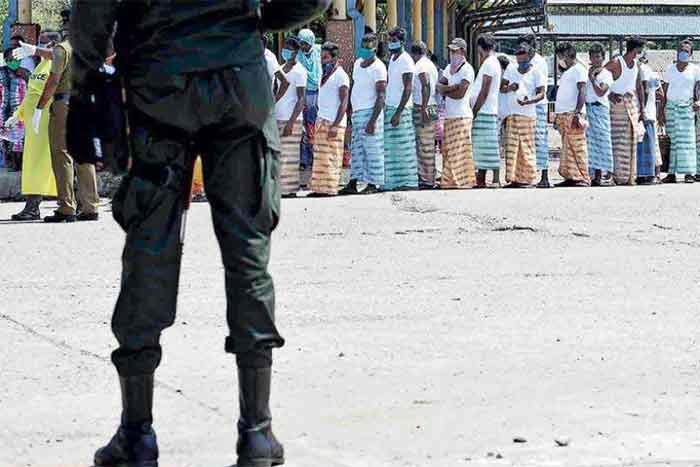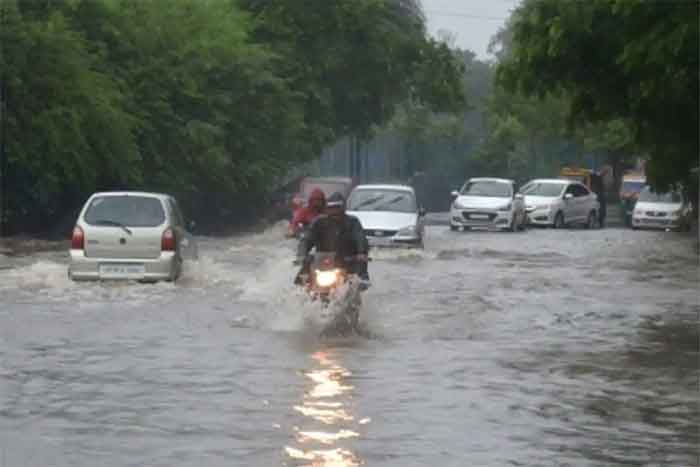
Note: This is the second in a series of articles on the economic and social crisis in Sri Lanka in the aftermath of Covid-19 by journalist Tushar Dhara who was in the country to report on the events there first hand.
On 18 March, 2020 – a week after the first local case of Covid-19 was reported in Sri Lanka – the government set up the National Operation Centre for Prevention of COVID 19 Outbreak (NOCPCO) and appointed a military official to head it. Not just any official, but Lt. Gen. Shavendra Silva. Silva, who was the acting chief of defence staff and the army commander, was the eleventh appointment of a serving or retired military officer to a government post by President Gotabaya Rajapaksa since becoming president in November 2019.
Silva’s appointment also signaled a desire to militarize the nation’s Covid response. This wasn’t surprising, given Gotabaya’s own military background and his explicitly stated desire for technocratic and military style governance during the Presidential campaign. The promise of a strongman who would enforce military discipline received the stamp of electoral approval, particularly as it was juxtaposed as an antidote to the coalition government and the 2019 Easter Sunday bombings.
The early days of the pandemic witnessed increased centralization and militarized governance. It opened the doors for the military to not just provide logistical support, but to coordinate the pandemic response and supplant civilian authorities. The government’s ability to keep the pandemic in check during the first wave was received well by the Sinhala-Buddhist majority, which gave Gotabaya Rajapaksa a massive victory in the Parliamentary elections of 2020. This was interpreted as approval for even more centralization in the mould of militarized governance. Within a few weeks the government introduced the 20th amendment bill, which rolled back many checks and balances introduced during the 2015-19 coalition government. The 20th amendment strengthened the executive presidency, provided immunity from legal challenge, and weakened independent institutions. Another development was the ramming through of the Port City bill through Parliament.
Shankitha Gunaratne, the deputy Executive Director of Transparency International, Sri Lanka told me that the bill was introduced on a Friday – before the weekend and a series of public holidays – which gave citizens just one day to challenge it in court. The Bill is meant to provide a legal framework for an international financial district being built in partnership with the Chinese on land dredged from the sea adjacent to Colombo Port.
 To be sure, many countries have used their militaries for Covid response since the beginning of the pandemic because armed forces have logistical experience and vast resources to deploy. For instance, China reportedly deployed 10,000 military personnel while France launched Operation Resilience. South Korea also mobilized its army. National military responses have been of three kinds: minimal technical support, blended civil-military responses and military-led responses. Sri Lanka’s Covid response falls in the third category and is all the more puzzling because the country has a robust public health sector. Typically, low and middle income countries with under funded health systems rely on the military to pick up the slack.
To be sure, many countries have used their militaries for Covid response since the beginning of the pandemic because armed forces have logistical experience and vast resources to deploy. For instance, China reportedly deployed 10,000 military personnel while France launched Operation Resilience. South Korea also mobilized its army. National military responses have been of three kinds: minimal technical support, blended civil-military responses and military-led responses. Sri Lanka’s Covid response falls in the third category and is all the more puzzling because the country has a robust public health sector. Typically, low and middle income countries with under funded health systems rely on the military to pick up the slack.
Another outcome of the militarization of the pandemic response was the establishment of Presidential task forces. In April 2020 the ambiguously worded task force to “direct, coordinate and monitor the delivery of continuous services and for the sustenance of overall community life” was established. In June two more were set up: A task force to build a “Secure Country, Disciplined, Virtuous and Lawful Society” and one for “archaeological heritage management in the Eastern Province”. All three were staffed with serving and retired military officers. Further, the archeological task force was interpreted as a move to appropriate land in predominantly Tamil areas in the North and the East under the pretext of the preservation of archeological sites while erasing Tamil and Shaivite history.
In effect, Sri Lanka’s Covid response was entrusted to NOCPCO and the ‘Community Life’ Task Force, both of which were staffed with alleged war criminals. Lt. General Shavendra Silva was sanctioned by the United States for war crimes during the final war against the LTTE in 2009, while the Task Force was entrusted to Basil Rajapaksa, President Gotabaya’s younger brother, who seems to have knowledge of war crimes. Not only that, Sri Lanka’s military led the government’s Covid response by playing a key role in contact tracing, surveillance, building and running quarantine facilities and distribution of essential services. Key civilian posts were either left vacant. For instance, Sri Lanka had no director general for health services several weeks into the pandemic. Others were filled by serving or retired military men including secretary to the health ministry and the director general of the disaster management centre.
In addition, several expert committees were constituted to provide guidelines on Covid-related issues. Among these was one appointed in December 2020 that recommended mandatory cremations, which was applied to the Muslim community. Despite lacking in scientific merit and contrary to WHO guidelines, burials were discouraged. It was only a few months later that the regulations were amended after criticism by domestic and international groups. The marginalization of Muslims predates the pandemic, as the 2014 riots against the community by ultra nationalist Buddhists underline. The pandemic gave a pretext to the government to further stigmatize the community.
The prioritization of the military over public health finds reflection in the national budget. In the budget for 2021, which was passed in December 2020, the health sector was allocated LKR 235 billion (6.34% of government expenditure, 1.3% of GDP) while defence got LKR 348 billion (9.2% of the expenditure, 1.98% of GDP). In my conversations with protestors at Galle Face greens, the topic of the role of the military and defence expenditure rarely cropped up. A Tamil person I met in Colombo who works in the development sector said that “nobody” is talking about the military’s role in Sri Lankan society, neither the international players nor the protestors. “Sri Lanka has a standing army of 300,000, which is larger than Ukraine’s,” the person, who spoke on condition of anonymity, said.
The militarization of the Covid response and its apparent success at controlling the first wave, along with strongman Gotabaya Rajapaksa’s promise of delivering “no nonsense” governance stripped of checks and balances emboldened the government to further centralize its decision making. It relied on a cabal of ‘voodoo economists’ to manage the economy, resulting in a series of decisions that has led to bankruptcy. The government has run out of money to pay its foreign debts and imports of food, fuel and fertilizer. The result is that people who handed an electoral majority to Gotabaya’s regime, seemingly impressed by the promise of militarized governance, have now turned against the regime. The political and economic crisis in Sri Lanka is partly a result of these trends that have plagued Sri Lanka throughout its independent history in one form or another, and have yet to be resolved.
Tushar Dhara is a journalist and researcher writing on both national and international affairs













































